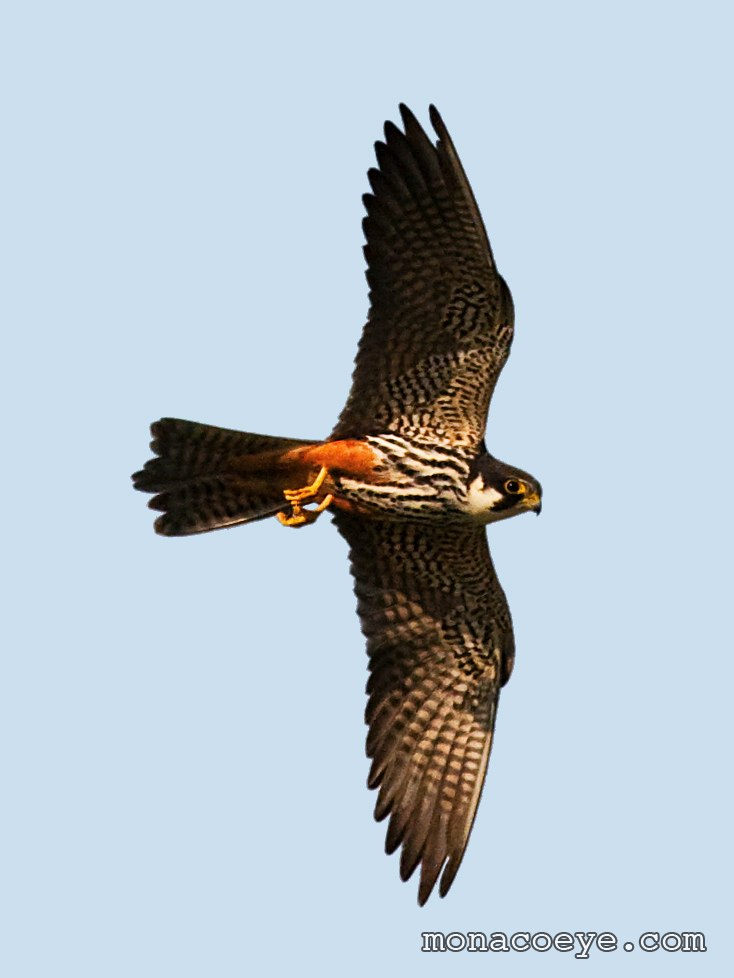Eurasian Hobby
Eurasian Hobby (Falco subbuteo)
The Eurasian Hobby (Falco subbuteo) is a small falcon, whose most striking feature is its rust-red " pants " are (leg feathers and under tail-coverts ). Much airborne occurring as the kestrel he is in front of the peregrine falcon, the second most common in Germany. The population trend is declining.
Description
The Eurasian Hobby is 30-36 cm long, the female is larger than the male. The top is dark slate gray, spotted the bottom streaky. The cheeks are white with a distinct beard Streif. In Flight image is reminiscent of an oversized swifts with narrow, pointed, sickle-shaped wings and a relatively short tail.
Distribution area
The Eurasian Hobby is almost over the whole of Europe ( British Isles: only south and the Baltic Sea region: only south of England, Scandinavia ), large parts of northern and central Asia, northern China spread to Kamchatka, Sakhalin and Japan.
The European population winters in southern Africa, the Asian in North India and Pakistan and in southern China.
Subspecies
- Falco subbuteo subbuteo L., 1758
- Falco subbuteo String In Hartert and Neumann, 1907 - China (less than subbuteo)
Habitat
The tree hawk breeds in copses, groves or forest edges. Preference is given to sparse pine trees, frequently it comes in other conifers before (clear spruce, pine stands in the south ), or deciduous riparian forests. Important is the adjacency of suitable hunting areas, so spacious, open and varied landscapes. During the breeding old ( by the late breeding season often this year ), are high- crows nests with free approach predominantly used. In some areas, are also high voltage pylons, used separately and related avenues of deciduous trees.
During migration of the Eurasian Hobby can be observed in almost all habitats, especially like he hunts to waters after dragonflies and insect-eating small birds.
Year cycle
After Germany, the tree hawk returns in April from its wintering grounds. The breeding grounds are open from May to early June. The courtship takes place with loud cries and with eye-catching maneuvers. As of early June, the female lays 2-3 eggs, rarely 1 or 4 eggs. After an incubation period of 28 days the chicks hatch. After about a month the young birds leave the nest and fly out a little later. Mid-August to early September, the families leave their territories and embark from the end of September on the train in the African winter quarters that lie south of the equator and extend to South Africa.
One-year birds moult in the summer, otherwise the moult takes place mainly in winter.
Voice
The typical call consists of a high, pointed " kikiki ", which is usually heard in a long, fast and then slowing Rufreihe. It sounds usually somewhat muted, a calling bird therefore often seems more distant than it actually is. There are a large number of other vocalizations, such as the so-called Lahnen, a soft " gjii ", which can also be heard during courtship.
Hunting way and nutrition
The way of the tree hunting falcons differs significantly from that of the smaller kestrels. He is an outdoor hunter who captured the glider after flying insects, especially beetles and flying ants. Especially in water and moorland are levels an important source of food. To his diet but also includes small birds such as larks ( " lark hawk" ), chokes or finches, and he is even able to capture, swallows and swifts in sloping or steep shock.
In the African winter quarters flying termites form its principal food.
Stock
The total number of tree falcon is estimated at the beginning of the 21st century on 71000-120000 breeding pairs. The distribution area is Russia, where 30000-60000 breeding pairs occur. The stock is in Germany 2700-3000 breeding pairs, coming in Austria 800-1200 breeding pairs before and Switzerland breed 400 to 600 pairs.










